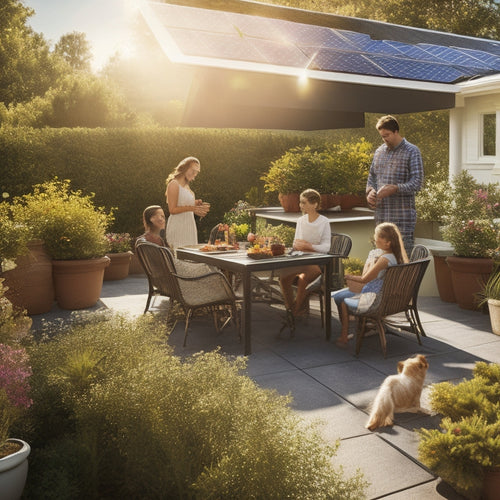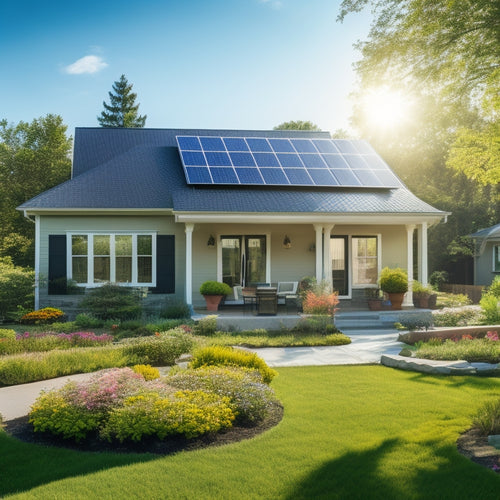
What Are the Top Solar Energy System Price Options
Share
You'll find that solar energy system prices vary widely, influenced by factors like system size, quality, and installation complexity. For residential systems, costs can range from $3 to $5 per watt, while commercial systems typically fall between $2.50 to $3.50 per watt. Installation permits, local building codes, and rooftop versus ground-mounted system choices also impact costs. To determine the most suitable price option for you, it's crucial to take into account these factors, as well as financing options like solar leases and power purchase agreements. By exploring these details, you'll uncover the best solution for your solar energy needs.
Key Takeaways
- Residential solar systems cost between $2.50 to $3.50 per watt, with average costs ranging from $15,000 to $30,000.
- Commercial solar energy systems cost between $2.50 to $3.50 per watt, with larger systems resulting in lower costs per watt.
- Solar lease options and power purchase agreements (PPAs) provide predictable monthly payments with minimal upfront costs.
- Federal and state tax credits, along with utility rebates, can lower upfront costs of solar energy systems.
- Cost comparison among installers and consideration of financing options help determine the best price option for a solar energy system.
Residential Solar System Pricing
With residential solar system pricing, you're likely to encounter a wide range of costs depending on several factors, including the system's size, quality, and installation complexity.
These costs can add up quickly, but there are ways to offset them. You can take advantage of solar incentives and tax credits, which can greatly reduce your upfront expenses. In addition, you'll need to factor in installation permits, which vary by location and can range from a few hundred to several thousand dollars.
Once your system is installed, you'll need to evaluate maintenance costs, which are typically minimal but can add up over time.
However, the energy savings you'll enjoy can more than make up for these expenses. In fact, a typical residential solar system can save you hundreds or even thousands of dollars per year on your energy bills.
Moreover, most systems come with warranties that can last up to 25 years or more, providing added peace of mind.
Commercial Solar Energy Costs
You're likely to find that commercial solar energy costs vary widely, depending on factors such as system size, installation complexity, and local building codes.
As you investigate your options, consider the following key factors that impact commercial solar energy costs:
-
System Size: Larger systems require more equipment and installation time, increasing costs.
-
Installation Complexity: Rooftop installations with multiple angles or obstacles can be more expensive than ground-mounted systems.
-
Local Building Codes: Compliance with local regulations and permits can add to overall costs.
- Solar Incentives: Federal and state tax credits, as well as utility rebates, can greatly reduce upfront costs.
Commercial solar energy systems typically range from $2.50 to $3.50 per watt, with average system sizes ranging from 50 kW to 500 kW.
While upfront costs may seem steep, commercial solar energy systems can generate considerable energy savings over their 25-year lifespan.
With the right solar incentives and financing options, businesses can break even on their investment in as little as 5-7 years.
Solar Panel System Installation
Now that you've considered the factors affecting commercial solar energy costs, it's important to examine the installation process that brings these systems to life.
You'll need to decide on the type of solar panel that suits your needs, whether it's monocrystalline, polycrystalline, or thin-film. Each type has its advantages, and your choice will impact the overall installation process.
The installation process typically begins with a site assessment to determine the best placement for your solar panels. This involves evaluating the amount of sunlight your location receives, as well as any potential obstructions.
Next, the installation team will prepare your roof or ground-mounted system, ensuring it's structurally sound and ready for the panels.
The solar panels are then installed, connected to an inverter, and tied into your electrical system. The inverter converts the DC power generated by the panels into AC power, which is then fed into the grid.
Average Cost per Watt Analysis
As the solar panel system installation process comes to a close, it's essential to examine the average cost per watt analysis, a vital factor in determining the viability of your commercial solar energy investment.
When evaluating solar pricing trends, you'll want to take into account the following key metrics:
-
System size: The larger the system, the lower the cost per watt.
-
Module efficiency: Higher-efficiency modules typically cost more per watt.
-
Installation complexity: Rooftop installations tend to be more expensive than ground-mounted systems.
- Location: Installations in areas with high labor costs or complex permitting processes will drive up the cost per watt.
Understanding these factors will help you make an informed decision about your commercial solar energy investment.
By analyzing the average cost per watt, you can compare prices among different installers and systems, ensuring you get the best value for your money.
This cost comparison will ultimately help you determine the return on investment (ROI) for your solar energy system.
Solar Energy System Financing
With your commercial solar energy system installation nearing completion, securing the right financing option becomes a critical step in bringing your project to life.
You'll want to investigate financing options that align with your business goals and budget. One popular choice is solar lease options, which allow you to lease the solar energy system for a fixed period, typically 7-15 years. This option provides predictable monthly payments and minimal upfront costs.
Another financing option to evaluate is power purchase agreements (PPAs). With a PPA, a third-party developer installs and maintains the solar energy system, and you purchase the generated electricity at a fixed rate, often lower than your current utility rate.
This option provides a hedge against rising energy costs and can help you achieve significant savings over time.
When assessing financing options, think about factors such as system ownership, maintenance responsibilities, and the overall cost of electricity.
Frequently Asked Questions
Can I Install a Solar Energy System Myself to Save Money?
You can attempt a DIY installation to cut costs, but be aware that improper setup may void warranties and compromise system efficiency, negating potential cost saving strategies, so weigh the risks before taking on the task alone.
How Long Does It Take to Install a Solar Energy System?
As you commence your solar adventure, you'll steer through a timeline that's as unpredictable as a sunny day with scattered clouds - typically 2-5 months, but installation challenges can prolong the process, testing your patience like a stormy weather.
Are There Any Local or State Incentives for Solar Energy Systems?
You'll find that many states offer rebates, while local governments provide grants to offset solar energy system costs; you'll need to research and claim these incentives, which can greatly reduce your overall expenditure.
Can I Sell Excess Energy Generated Back to the Grid?
Surplus solar savvy sparks savings: you can sell excess energy back to the grid through net metering benefits and energy buyback programs, offsetting your utility bills and amplifying your renewable returns.
How Often Should I Clean My Solar Panels for Optimal Performance?
You should clean your solar panels every 6-12 months for peak performance, as dirt and debris can reduce energy output by up to 25%; regular panel maintenance involves inspecting and cleaning your panels at the recommended cleaning frequency.
Conclusion
You've made it to the end of our extensive guide to solar energy system pricing! Now, you're an expert on maneuvering the intricate world of residential and commercial solar costs, installation details, and financing options. With an average cost per watt analysis under your belt, you're ready to utilize the power of the sun like a pro. Remember, going solar is a smart investment - you'll be saving the planet and your wallet in no time!
Related Posts
-

Long-Term Cost Savings With Solar Panels
Investing in solar panels offers substantial long-term savings on energy costs. You'll benefit from federal tax credi...
-

High-Performance Energy-Efficient HVAC Systems
High-performance energy-efficient HVAC systems are essential for reducing energy consumption while improving indoor c...
-

Affordable Solar Panels for Home Use
Affordable solar panels offer you a smart way to cut down on energy costs while promoting sustainability. With govern...


